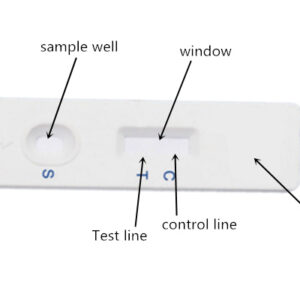Description
It is suitable for in vitro quantitative detection of the concentration of pepsinogen I (PGI) in human whole blood, serum or plasma samples. The relationship between pepsinogen and the development of gastric mucinous gland lesions: “serological biopsy” of gastric mucosa, superficial gastritis and H.Pylri-infected gastritis, increased secretion of PGⅠ and PGⅡ; chronic atrophic gastritis, PGⅠ content when the principal cells are reduced Decrease; when atrophic gastritis is accompanied by intestinal metaplasia and pseudopyloric gland metaplasia of gastric antral glands, the content of PGⅡ will increase accordingly. Related clinical or laboratory diagnostic methods include endoscopy (gastroscopy), X-ray barium meal examination, B-mode ultrasound examination, exfoliative cytology and other methods.
The principle of the kit: Two strains of highly specific and sensitive anti-human PGⅠ monoclonal antibodies are used. Among them, the concentration of PGⅠ monoclonal antibody I is fixed in the detection area on the membrane, and the quality control area is coated with rabbit anti-chicken antibodies. Fluorescently labeled PGI monoclonal antibody II and chicken antibody are stored in buffer. The double antibody sandwich method is used in the detection area, the antigen-antibody reaction is used in the quality control area, and the immunochromatographic technique is used to detect the content of pepsinogen I in human blood.
The working principle of the supporting instrument: Insert the reacted detection card into the JW-98 fluorescence immunoassay analyzer, and the measuring system of the instrument automatically scans the binding area of the label and the analyte to obtain the optical signal. Then the optical signal is measured and analyzed, and the concentration of the measured substance can be obtained quantitatively.
Clinical significance:
- Hypersensitive C-reactive protein (CRP): A protein that can bind to the C-polysaccharide of pneumococcal cell wall in the serum of patients with acute inflammation.
- Neutrophil gelatinase-associated lipocalin (NGAL): a biomarker of early renal damage.
- Procalcitonin (PCT): When human tissues are infected by bacteria, the concentration of procalcitonin (PCT) in the serum will increase significantly.
- Pepsinogen (PGI): When the gastric mucosa undergoes pathological changes, the serum PG content also changes.
- Pepsin (PGII): The abnormality of PGII is often related to the pathology of the gastric antrum.
- Heart-shaped fatty acid enzyme binding protein (H-FABP): It is a highly sensitive early marker of myocardial ischemia, which can be detected 30 minutes after an ischemic attack.
- Myoglobin (MYO): In acute myocardial injury, MYO is quickly released into the blood.
- Creatine kinase isoenzyme (CK-MB): When various pathologies including muscle atrophy and myocardial infarction occur, the level of creatine kinase in human serum increases rapidly.
- Troponin (cTnI): a specific biochemical marker for the diagnosis of acute coronary syndrome (ACS).
- D-Dimer (D-Dimer): cross-linked fibrin clot derived from plasmin solubilization. Increased or positive is seen in secondary fibrinolytic hyperfunction, such as hypercoagulable state, diffuse intravascular coagulation, kidney disease, organ transplant rejection, thrombolytic therapy, etc.
- N-terminal brain natriuretic peptide precursor (NT-proBNP): N-terminal brain natriuretic peptide precursor is an inactive N-terminal fragment after the division of B-type natriuretic peptide prohormone, which is a typical cardiac marker. It is mainly secreted by the left ventricle when the volume load on the cardiomyocytes increases.
Product advantages
- Utilize the huge difference between the fluorescence wavelength of the lanthanide rare earth element and its excitation wavelength;
- The unique ultra-long fluorescence lifetime can be detected when the excitation light source is turned off to improve the signal-to-noise ratio;
- The immune particles contain a large amount of fluorescein, and the signal intensity is high.
Specification: 50T



